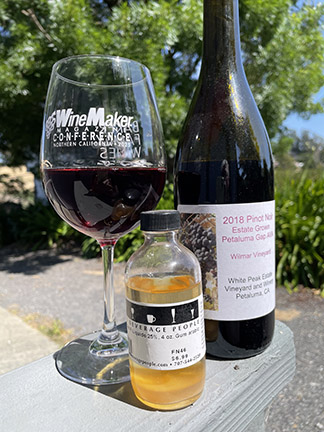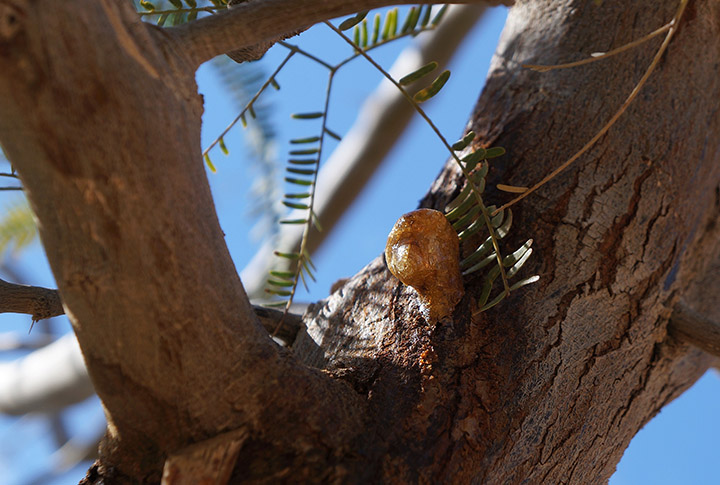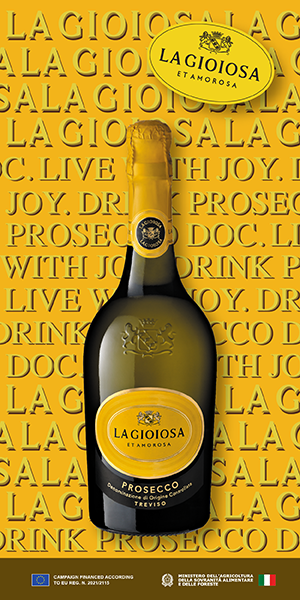
When I wrote a “Techniques” column about vegan winemaking products, one natural material with a long history of use caught my attention: Gum arabic. In today’s column, we will look in more detail at the history and use of this vegan, natural, and highly versatile wine treatment product. People around the world have been using various tree sap resins or gums, including the one known as gum arabic, for hundreds or even thousands of years.
Gum arabic got its name in European trade in the Middle Ages when it was exported to Europe through Arabian ports. Then, as now, it was produced primarily in the Sahel region of Africa, a band of semi-arid savanna along the southern edge of the Sahara Desert. Also known as gum acacia, it is not farmed, but rather is harvested from wild acacia trees. Semi-nomadic people maintain the harvest of acacia sap that is exuded from minor cuts made to the branches and trunks of several different species of acacia, most commonly Senegalia senegal (aka, Acacia senegal) and Acacia sayel. Being harvested from trees in the wild, the gum is naturally vegan and can be listed as not derived from genetically modified organisms. Just as in ancient times, the dry solid unrefined gum is exported from Africa — Sudan has long been the largest producer — and further processed by European manufacturing companies for uses including paint, pigments, non-toxic adhesives, and wine treatment products. Long recognized as an anti-flocculant, it helps keep materials from precipitating in a variety of liquid applications, including wines, vinegars, and liqueurs. Modern synthetic anti-flocculants like carboxymethylcellulose (CMC) now occupy part of that market niche, but gum arabic remains readily available to home winemakers, is effective, and easy to use.
On a molecular level, gum arabic is a complex mixture of primarily two kinds of polymers: Polysaccharides and glycoproteins. As the names of those polymer types indicate, they are built up from sugars (saccharides) and sugars combined with proteins. Evaluated together, these long chains or macromolecules may be considered a related group of polymers known as arabinogalactan-proteins (AGPs). Simple sugar molecules make up a large portion of each of the polymer structures. Another polysaccharide we encounter in winemaking, cellulose, is made up entirely from building blocks of the familiar 6-carbon sugar called glucose. AGPs, however, are highly branched chains built from the 5-carbon sugar arabinose and the 6-carbon sugar galactose. The gum polymers are further differentiated by the extent of protein content. When dissolved in wine, the polymer chains of gum arabic interact with potentially unstable components in the wine, such as tartrates and polyphenols, by hydrogen-bond attachments to those compounds. The complex that results presents a hydrophobic barrier to other unstable molecules and prevents them from combining and precipitating. Although often grouped with fining agents such as proteins or bentonites, gum arabic differs in a fundamental way. Instead of precipitating and dropping out unstable or unwanted compounds, it masks them and holds them in solution. Settling and filtration are not required after gum arabic treatments because the target molecules are held safely in place rather than dropped out.
The Many Uses of Gum Arabic in Winemaking
A process for treating wine to avoid precipitation of tartrate crystals, sometimes called “wine diamonds,” is called cold stabilization. For home winemakers, the most common method of cold stabilization is to hold the wine in bulk at a temperature near freezing for a time sufficient to precipitate any unstable tartrate compounds. The wine is then racked off of the settled tartrates and aging or bottling can proceed. If time, equipment, or space prevents the use of conventional chilling, the home winemaker can turn to treatments with metatartaric acid, carboxymethylcellulose products, or today’s subject, gum arabic. In practical terms, gum arabic has several advantages. It is readily available in small amounts, it is simple to use, and it is very unlikely to cause any further difficulties in the wine after treatment.
If a young red wine comes across as too astringent or tannic, gum arabic can help there, too. In coating the polyphenolic tannin molecules, the gum polymers mask them from taste or astringency effects on the palate, rounding out and smoothing the presentation of the young wine. The sugars that make up gum arabic do not represent any risk of refermentation by yeast that may still be present in the wine. They do, however, offer a slight impression of sweetness to the wine drinker’s palate. That means that when bench trials show that a slight increase in sweetness will enhance fruitiness and make a wine more enjoyable, you need not necessarily go the route of backsweetening with sugar. Wine backsweetened with sugar needs to be stabilized with the addition of potassium sorbate to prevent refermentation or needs to be sterile filtered, but unfermentable gum arabic does not carry a refermentation risk.

This remarkable material can also address other wine deficits. If a wine seems thin and watery, but otherwise sound, try gum arabic. Because of its stable polysaccharide structure, it imparts a sense of fullness and roundness on the palate. It may be just what your wine needs to build body without seriously altering flavors or introducing instability. Color stability in young red wines is another area of interest for gum arabic treatment. Over years of advising home winemakers, I have often seen the problem of a red glaze precipitating on the glass bottle side walls while aging a young red wine. My general advice has been to extend the bulk aging time on the next occasion of making a wine from the same grape source. That is, allow the pigments to react with polyphenols and drop out in barrel, tank, or carboy instead of in the bottle. However, if either allowing that much time, or the resulting reduction of color intensity in the wine is unacceptable, you may treat with gum arabic. When the tannin molecules are masked by the AGP polymers, they are rendered unreactive and remain in solution, preserving color and preventing precipitation.
Using Gum Arabic
Gum arabic products are available as a purified dry product or in a prepared liquid solution. The dry products have longer shelf lives, but the liquid products are much easier to apply. In most applications, gum arabic is the last commercial product used in a wine before bottling (other than a possible final sulfite addition). In previous discussions of gum arabic use, I have noted that it must be applied after any final filtration due to risk of clogging the filter media. While there is no particular need to filter a wine after a gum arabic treatment, product suppliers have since introduced purified formulations that can allow pre-filtration addition if desired. These are noted in product literature and instructions. One essential characteristic remains — the need for complete and reliable mixing with the wine to assure AGPs have adequate opportunity to interact with target compounds. While continuous injection via a metering pump is recommended for commercial wineries, that equipment is beyond the scope of most home winemakers. Instead, after conducting your bench trials and establishing your best dose rate, mix the gum arabic with your otherwise finished wine at least 24–48 hours before bottling.
As a natural material generally recognized as safe for human consumption, gum arabic addition to wine does not represent a health risk. European winemaking regulations limit legal additions to no more than 300 mg/L (1.14 g/gallon) dry gum equivalent in treated wine. That limited amount can be weighed directly for solid materials. For liquid preparations, the concentration as produced must be considered.
One liquid product is Flashgum R Liquide, produced by IOC (Institut Oenologique de Champagne) and distributed by Scott Laboratories. It is derived from Acacia seyal and is packaged at approximately 25% gum arabic. As with other liquid gum arabic preparations, it includes potassium bisulfite as a preservative. The typical dose rate in use is 40–120 mL/hL or 1.5–4.5 mL per gallon. Bench trials over the recommended dose range should be carried out. It is capable of passing through a 0.45-micron final filter on a bottling line, but using it post-filtration is recommended. Since it is already a liquid product and preserved with sulfite, no further preparation is needed before use.
Stabivin SP from Laffort is another liquid product that is described as highly purified and having a very low clogging index, thus not representing a filtration problem in use. It is produced with a gum concentration of 200 g/L and the recommended dose range is 100–150 mL/hL (3.8–5.7 mL/gallon). It is also preserved with sulfites.
A solid gum arabic product for wine treatment is Dry Gum L from Perdomini-IOC in Italy. It is a high-quality powdered gum arabic derived from Acacia senegal. It does not contain sulfites and, as pure gum arabic, the maximum dose rate in wine is limited to 300 mg/L or 30 g/hL or 1.3 g/gallon. Like the liquid preparations, its use is recommended either before or after filtration that precedes bottling. Particularly recommended to avoid unwanted color precipitation problems, bench trials to determine the optimum dose rate are advised.
My Own Experiences
In practical terms, this remarkable wild-harvested material with multiple applications seemed like a product I would need to explore in my own home winemaking. I grow Pinot Noir and Chardonnay grapes in a 1⁄3-acre hobby vineyard in the Petaluma Gap AVA of Sonoma County, California. This is a cool-climate region, and my grapes reach harvest at moderate sugar levels and sometimes at high acid concentrations. With the Pinot Noir, the resulting wine may show excessive harshness and astringency when young, although it mellows quite well with barrel aging. To experiment with gum arabic, one vintage a few years ago I bought a small bottle of a liquid preparation from my local home winemaking store. Before bottling day that year, I racked the estate Pinot Noir one last time to carboys and sulfited them. To one of the 5-gallon (19-L) carboys, I added a mid-range dose of gum arabic. I am a proponent of bench trials, but in this case, I was not solving a problem so much as trying out a product, so I went directly to the mid-range level in the experimental carboy. As I bottled the wine, I marked the two cases that came from the treated carboy and set them aside.
After a few weeks of waiting to be sure any bottle shock had resolved, I tasted the wine treated with gum arabic alongside the untreated wine. There was a perceptible improvement in smoothness and roundness on the palate, but it was very subtle. To detect the gum arabic difference on that wine, I had to taste them side-by-side to make it apparent. When I served bottles separately to guests on later occasions, neither version revealed noticeable differences. Because it introduced no negative characteristics and showed promise of improvement when closely observed, I would conclude that if I did have a problem of astringency, color precipitation, or cold instability in a wine I would be open to trying gum arabic again. If you have a wine that shows (or might show) this kind of problem, do not hesitate to give this storied natural product a try.






